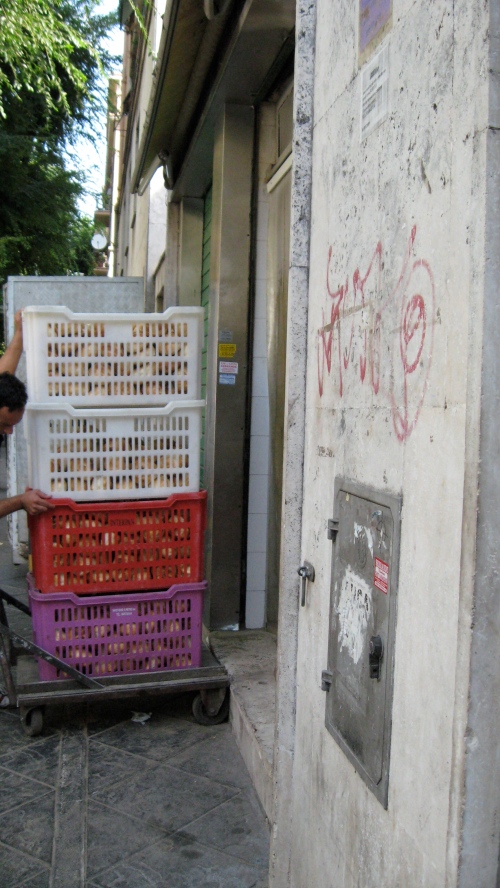In my last post, I attempted both to recommend Food Inc., and to criticize what I saw as the overly facile closing message (“vote with your fork”). There was more to the event, here at the American Academy in Rome, and there is a positive alternative to the dark suggestion of the film that Monsanto may well take over the world. Briefly, these follow-ups/upsides have to do with braised pork and grass-roots.
Let’s start with grass-roots. Since the screening, I’ve talked with a lot of people about how depressing the film is. It seems to offer only the meager solutions of “voting with your fork” and waiting for policy change to adjust the prices of food. Obviously, more needs to be done and can be done. One of the people I’ve talked with a lot about these issues is Mona Talbott, the executive chef here. She is passionate not only about great cooking but also about reforming American food culture through cooking education. An over-reliance on convenient but unhealthy fast-food is in part a consequence of a general lack of cooking skills and knowledge. Another part of the problem is the misconception that fast food is cheaper than home-cooked food. This doesn’t have to be the case. The Rome Sustainable Food Project works on a tight budget to provide nutritious, delicious, and sufficient food for all of us. Mona points out that the world’s oldest traditional diets, like that in Italy, have had such long histories of sustaining people in part because they can sustain—with complete nutrition—the most people. In other words, traditional diets are complete, and they are poor people’s diets. The basis of the Italian diet is the lowly triumvirate of beans, grains, and greens. These are affordable. Pasta is cheap. The cheapest cuts of meat are delicious when cooked slowly.
But cooking, which often isn’t learned in the family anymore, needs to be learned if families are to be fed on these inexpensive foods rather than on fast food. Actually, many people don’t know anything about food anymore, much less cooking! If you take a look at my friend Sharyn’s comment on my last post, you’ll see what I’m talking about. She teaches in a university, and her students don’t know about the seasonality of any foods.
Several things need to, and can, happen, with a grass-roots effort. More communities can take on the reform of school lunch on their own, and even put in edible schoolyards (playground gardens) and teaching kitchens. Children, then, can teach their parents about seasonality and cooking. Or they can learn about food and cooking by asking their grandparents, as their doing with the help of Bioversity’s campaign Diversity for Life. Cooking schools can teach home cooking. Institutional kitchens—like the one here, with its unpaid interns—can double as educational kitchens. Old routines, like canning parties, can be revived. (Mona mentioned this today, and you might recall one of my recent posts about the biodiversity scientist I met recently, Stephan, who has fond memories of tomato-canning parties in a neighbor’s garage.) Children can be taught the basics of cooking, and along with those, the comforts and thrills of cooking, by being included in the process of growing and making food. With the encouragement of children and community-based campaigns, working parents can be convinced to plan ahead and find the time to put together a healthy meal—even if it’s just rice, beans, and something green.
Mona, who has cooked for the best restaurants and wealthiest people, wants to devote herself to this grass-roots cooking re-education effort when her tenure as the head of the Rome Sustainable Food Project ends. She’s a real inspiration.
* * * * * * *

Immediately after the film screening on Saturday, we participated in a panel discussion with two of the farmers who sell their organic foods to the Rome Sustainable Food Project: Enzo Foi, who came with Filippo da Sole, from the farm and agriturismo destination Lo Spicchio; and Giuseppe Brandizzi, from the organic dairy Biola. The audience had many questions about organic agriculture (agricoltura biologica) in Italy, food politics in Italy, and the differences between the U.S. and Italy on these matters. Enzo told us, without the wish to romanticize Italy for the mostly American audience, that the main difference between the U.S. and Italy, in terms of industrial agriculture, is scale. Here, as in the U.S., there is a large industrial-farm lobby that shapes the politics; synthetic pesticides, herbicides, and fertilizers are used (although the European Union has outlawed GMOs and rBST); small-scale farmers are going out of business. But, also as in the U.S., there is a movement to expand sustainable agriculture, and to encourage buying locally produced food, and some politicians are helping to promote these causes. (There are, of course, differences. Italians know how to eat and have a culture of food, for one!)
More important than the help of politicians, though, is the grass-roots movement exemplified by these men and their families, who are educators and cooks as much as they are farmers. They farm and cook and eat the way they do because they want to preserve the land, foods, and traditions that have sustained people for centuries and that could—if not cared for—be lost to oblivion. If you’ve seen Food Inc., consider the proud strut of this rooster compared to the falling-down factory chickens:

Lo Spicchio gallo
After the film and discussion—and in spite of the revolting images of factory farming we’d just seen—we all eagerly went upstairs to the dining room to eat a meal prepared with the ingredients from Enzo’s and Giuseppe’s (and a few others’) farms. We ate Lo Spicchio pork braised in Biola’s whole raw milk; cardoons roasted with lemon and buttery breadcrumbs; polenta; local red wine; and the most flavorful “blondies” I can imagine. (We eat a lot of braised meat here, in part because Mona and Chris like to cook the whole, traditional, foods of everyday Italians. The braising cuts are the cheapest cuts. The other night, Chris and the interns cooked up an amazing meal of braised lamb with harissa, chickpeas with greens, and cous cous. Simple. Complete. Delicious.)
Read Full Post »




 Italy’s Parliament
Italy’s Parliament 





















